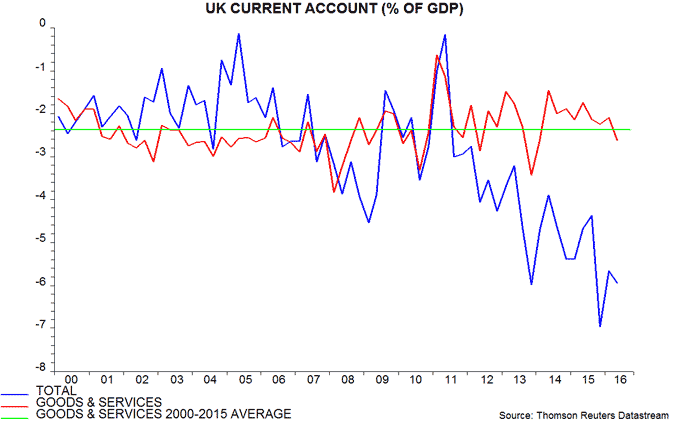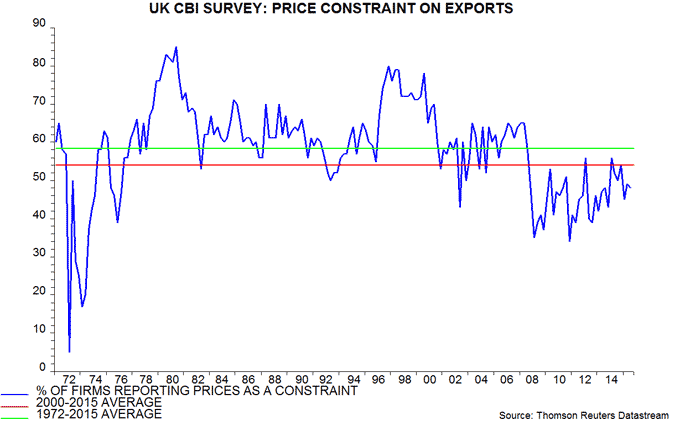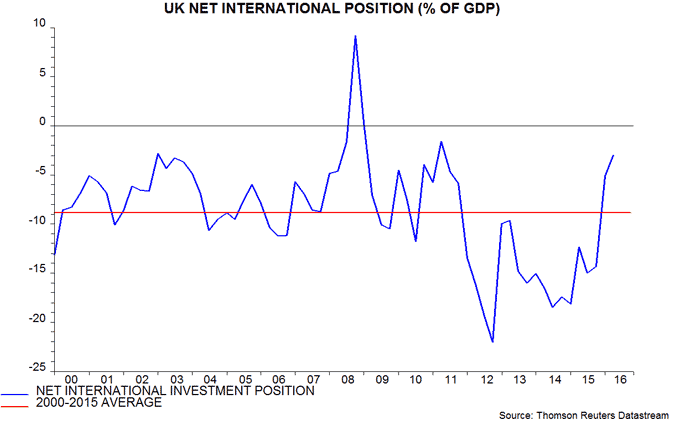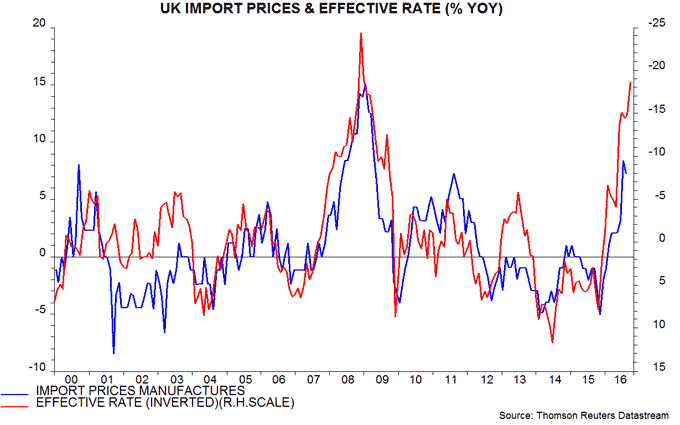Entries from October 2, 2016 - October 8, 2016
Sterling not overvalued before Brexit vote
Brexit-supporting economists argue that the referendum result hastened a fall in the pound that was inevitable and will ultimately prove beneficial. Such claims are dubious.
The Brexit supporters cite the large current account deficit – equivalent to 5.9% of GDP in the second quarter of 2016 – as evidence that the pound was significantly overvalued. The trade deficit in goods and services, however, was 2.6% of GDP in the second quarter, close to its average of 2.4% between 2000 and 2015. It has been trendless in recent years despite relatively strong UK domestic demand growth – see first chart.
Business survey evidence refutes the claim that the pre-referendum level of the exchange rate was limiting export performance. The percentage of CBI industrial firms citing pricing as a constraint on exports stood at 49% in April, below a 2000-15 average of 54%. The long-term average (since 1972) of this series is 58% – second chart.
The rise in the current account shortfall has been driven by a move from surplus to deficit in the investment income balance. This move, however, has reflected a change in the form of the return received on foreign assets from income to capital gain. The cumulative capital gain on the net international investment position in recent years has exceeded not only the income deficit but also the overall current account shortfall. The net investment position (i.e. external assets minus liabilities) stood at -5.1% of GDP at the end of the first quarter (before the referendum) versus a 2000-15 average of -8.8% – third chart.

An alternative view is that the fall in the pound was not inevitable but has been the result of international investors revising down their assessment of the equilibrium value of the exchange rate in response to 1) the UK opting for inferior trading arrangements with its largest export market and 2) post-referendum monetary and fiscal loosening. The MPC bears significant responsibility – cutting rates and launching more QE when broad money is growing at a double-digit pace* is a recipe for a weak currency.
Monetary trends were signalling a rise in inflation in 2017 well before the Brexit vote. Sterling’s slide will accelerate the pick-up as import prices surge – fourth chart. CPI and RPI inflation are expected here to rise above 3% and 4% respectively during the course of next year. Will Brexiters comfortable with the pound’s decline also defend these increases as inevitable and necessary?
*M4ex rose at an annualised rate of 11.3% in the four months to August.
Global economic pick-up on track
Incoming monetary and economic news is consistent with the central view here that US / global growth is gaining momentum and will prove stronger than policy-makers and the consensus expect over the next six to 12 months. This view implies that: 1) the Fed was wrong to defer raising rates in September (just as it was wrong to hike in December 2015 when monetary trends were signalling economic weakness); and 2) pressure for additional monetary policy relaxation in other major countries will ease, possibly benefiting investments that have suffered from moves towards low / negative rates (e.g. financial stocks).
Global narrow money strength is the key reason for economic optimism. Full monetary statistics for August confirm that six-month growth of real (i.e. inflation-adjusted) narrow money in the G7 economies and seven large emerging economies (the “E7”) rose to its highest level since 2009, ahead of a sustained period of solid economic expansion. Real broad money growth has also firmed – see first chart.
The rise in real narrow money growth began in the E7 – with China a key driver – but has spread to the G7 more recently, reflecting increases in the US and Japan. The E7-G7 differential turned positive in late 2015 ahead of this year’s outperformance of emerging market assets; the gap has narrowed but has yet to reverse sign, suggesting retaining overweight EM positions – second chart.
The positive signal from global monetary trends has been confirmed by a pick-up in a non-monetary composite leading indicator for the G7 plus E7 economies derived from OECD country leading indicator data. An August reading of this indicator will be available next week but calculations here suggest that the G7 component has continued to gain momentum – third chart.
Country-level data over the past week provide further evidence that the global economy is lifting:
1) The new orders index of the US ISM manufacturing survey rebounded strongly in September after an August slump. The latter decline seems to have been a “Brexit echo” of the sharp fall in the corresponding UK survey index in July, which has since been more than reversed – fourth chart.
2) Japanese industrial output rose by a stronger-than-expected 1.5% in August, with METI’s survey of manufacturers projecting further gains of 2.2% and 1.2% in September and October. The latest Tankan business survey, meanwhile, reported a further rise in labour shortages, suggesting that recent upward pressure on real wages will be sustained – fifth chart.
3) Chinese producer prices continue to firm, with the input price index of the NBS manufacturing survey rising to 57.5 in September, marking the eighth month comfortably above the 50 level – sixth chart. The return of pricing power is a key reason for the recent surge in industrial profits, which promises a recovery in business investment over coming quarters – see previous post.
4) The German Ifo manufacturing survey reported the strongest business expectations for 18 months, suggesting a swift reversal of July industrial output weakness, which appears to have been mainly due to holiday timing effects – seventh chart.
5) UK services output rose by 0.4% in July, in line with the projection in a previous post, after an upwardly-revised 0.3% June gain. GDP now looks on course to rise by at least 0.4% in the third quarter following a bumper 0.7% second-quarter increase – a huge embarrassment for analysts who claimed that the economy was flatlining before the Brexit vote and would contract in response to the shock result.
